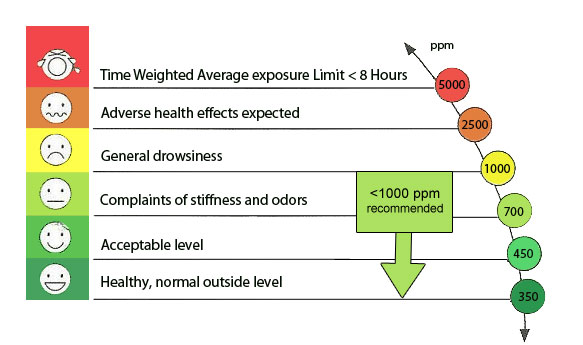What qualities do you seek in a district of schools? Educator caliber? Reputation? How well-rounded are their athletic teams and extracurricular activities? Do you ever consider the indoor air quality in school buildings, though?
According to a survey of school districts conducted in 2014 by the National Center for Education Statistics (NCES) in the United States, the country’s primary school buildings are on average 55 years old. Additionally, concerns with indoor air quality have been noted in about half of these buildings (IAQ).
According to studies by the U.S. Environmental Protection Agency (EPA) on human exposure to air pollutants, interior air pollution levels can be two to five times higher than outside levels, and on rare occasions more than 100 times higher. Given that the majority of individuals spend about 90% of their time indoors, these levels of indoor air pollution are very concerning.
So, what exactly is IAQ? In terms of the health and comfort of building occupants, the EPA defines Indoor Air Quality (IAQ) as “the air quality within and surrounding buildings.” You can lessen your risk of indoor health issues by being aware of and controlling common indoor contaminants. However, pollution is not the only issue. Because thermal comfort conditions are a major element in air quality, temperature and humidity also play a role in this. A healthy indoor atmosphere and “good” IAQ are essential for schools to achieve their main objective of educating students. One of the numerous elements that affects learning and productivity in the classroom, which in turn affects performance and achievement, is the health and comfort of the students and teachers.
IAQ issues can have a more negative impact on staff and kids’ short- and long-term health if they are not prevented or minimized. Coughing, eye irritation, headaches, allergic responses, aggravated asthma, and/or other respiratory disorders are a few of these that may occur. Any one or all of these factors may have an effect on students’ performance, comfort, and attendance, as well as on the effectiveness of teachers and staff.
But how do you know if the air quality is good? Monitoring carbon dioxide (CO2) levels in the classroom is the most straightforward way to make sure that a space is adequately ventilated, which contributes to maintaining high levels of indoor air quality. When you exhale, CO2 is released into the atmosphere. In order to assess the quality of the air in a room, you can use the CO2 level to evaluate whether it is appropriately ventilated with outside air.
It’s crucial to remember that elevated CO2 levels can also contribute to poor air quality. High CO2 levels have been shown to have an adverse effect on cognitive function. This may affect our capacity for decision-making, upholding a high standard of work, as well as learning and communicating successfully. IAQ therefore has a significant impact on workplace productivity, life outcomes in education, and clinical results in hospitals.

In a Demand-Controlled Ventilation (DCV) situation, CO2 sensors connected to the Energy Management System (EMS) normally keep track of the CO2 levels in a space. The amount of fresh outside air to be introduced into the space will be decided by the EMS based on the respective CO2 level, which is also a good proxy for the number of occupants in the room. By using this technique, the area will be adequately ventilated while consuming less energy and paying lower running expenses. In this situation, the CO2 levels are typically kept at or below 1,000 ppm.
The Centers for Disease Control and Prevention (CDC) have issued a number of suggestions to assist reduce exposure to SARSCoV-2 virus particles during the current COVID-19 pandemic, nevertheless. One suggestion is to turn off the DCV system and add more fresh air as needed to keep CO2 levels between 600 and 800 ppm while keeping an eye on the humidity and comfort levels in the area. Maintaining the lower CO2 level reduces the likelihood of virus transmission if an infected individual is present in the area.
Pollutant levels may rise in a structure with insufficient outside air intake, which could have negative effects on both health and comfort. The amount of outdoor air that can “leak” into and out of a building may not be sufficient to ensure quality indoor air conditions, which can lead to greater indoor pollutant levels, unless structures are built to include a mechanical means of ventilation. The number of times students visit the nurse’s office, the amount of sick leave taken, and everyone’s overall health and wellbeing can all be improved by enhancing and maintaining optimal indoor air quality.
In conclusion, there is a lot of concern about the air quality in schools. Indoor air maintenance requires more than just “quality” considerations. Safety and good stewardship of your investment in kids, employees, and buildings go hand in hand with clean indoor air. The presence of CO2 is a reliable sign that an area is well-ventilated and has high air quality. Students and staff can perform at their highest levels because to the quality indoor air that is available.
GZAIR ADVANTAGE
GZAIR Detectors – is a trusted air quality monitor and gas detector manufacturer, we provide advanced CO2, Carbon Monoxide, humidity, temperature, PM2.5, TVOC, and radiation sensors for residential, HVAC, automotive, industrial, and healthcare markets.
References:
https://www.epa.gov/iaq-schools/take-action-improve-indoor-air-quality-schools-air-quality-schools

Leave A Comment